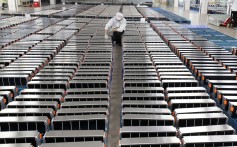China is moving up the rare earth value chain. The West is trying to catch up
- It used to provide cheap raw materials to Western nations to make high-end products for clean energy
- Now China is importing upstream products, then exporting the downstream, value-added ones
Listen to this articleLast month, a Chinese firm acquired the entire stockpile at Canada’s first and only operating rare earth mine. Shenghe Resources also bought a 9.9 per cent stake in Vital Metals, the Australian company that owns the project.
Shenghe has been importing rare earths from American and Australian miners and processing them in China since 2016.
Rare earths are used in clean-energy technologies such as electric vehicles and wind turbines, and China has had a leading position supplying the world with these elements since the 1980s. But it is also well ahead on the technologies used to process rare earths.And as Western countries develop their own rare earth supply chains to reduce reliance on China, acquisitions like Shenghe’s show how China is seeking to import upstream products from the West, then export value-added products back to these countries.
So while China used to provide cheap raw materials to Western nations to make high-end products for clean energy, it is now attempting to reverse that production flow in the global value chain.
Western nations are developing their own rare earth supply chains to reduce reliance on China. Photo: ReutersIn the rare earth supply chain, upstream production involves the mining of the elements and the extraction and separation of their oxides. Downstream is mainly the production of permanent magnets, used for electric vehicles.
Rapid exploration and mining of rare earth deposits and a leading position on separation and extraction technologies saw China dominate exports of raw ores and other upstream products.
Prices were extremely low and there were serious environmental concerns, prompting efforts to improve the industry, with exports of raw ores banned in 2009, and controls imposed on domestic rare earth production.
EVERY TUESDAYChina Economic UpdateRead key economic stories from China, including the US-China trade war, sanctions, and economic developments.GET OUR NEWSLETTERBy registering, you agree to ourT&CandPrivacy PolicyDuan Xiaolin, assistant professor of global studies at Chinese University of Hong Kong in Shenzhen, said China was attempting to make its use of rare earth resources sustainable.
“These efforts include environmental regulations, production control, and industrial restructuring to consolidate rare earth production among state-owned enterprises, which has led to an undersupply of rare earth raw ores within China,” Duan said.
Meanwhile, Western countries led by the United States, Australia, the European Union and Canada have sought to develop a new rare earth supply chain so they are less dependent on China.
That has seen China’s share of total rare earth exports drop from some 90 per cent a decade ago to about 70 per cent in 2022, according to the US Geological Survey.
And with an undersupply at home, China’s rare earth industry has had to rely more on imports of upstream products to process.
Imports have grown significantly – from 14,274 tonnes overall in 2016 to about 10 times that volume in 2022.
The industry imported 2,759 tonnes of rare earth oxides, an upstream product, in 2016 – and 10 times more in the first half of 2023.
It also went from importing just 2 tonnes of raw ores in 2016 to imports of more than 70,000 tonnes annually in the last three years.
“Chinese companies are importing raw materials from abroad and actively seeking to diversify to meet their need for raw materials, with Shenghe Resources being a notable pioneer in this regard,” Duan said.
In recent years, Shenghe has acquired stakes in two Australian companies that own rare earth mines in Greenland and Tanzania, as well as a stake in the owner of the largest such mine in the US. That mine, named Mountain Pass, produces about 15 per cent of the world’s rare earths, according to its website.
These deals have given Shenghe exclusive rights to buy rare earth concentrates produced at the mines.
From 2017 to 2022, the company, which is partially state-owned, has spent about US$248 billion annually on rare earths from foreign mines – far more than its purchases of domestic rare earths.
In the December deal, the Chinese company acquired the Canadian mine’s stockpile and it will also work with Vital Metals to develop another mine in Tanzania.
Shenghe’s recent acquisitions are part of a broader Chinese strategy to move up the rare earth value chain.
As China buys more upstream products from abroad, its exports of rare earth permanent magnets – a high-demand and high-value-added downstream product – have roughly doubled from 2016 to 2023. They are exported to countries including the US, Germany, Italy, Poland and Vietnam.
Kevin Ansdell, a geological sciences professor at the University of Saskatchewan in Canada, noted that the West was behind when it came to the refining part of the rare earth supply chain.
“So if you develop a new rare earth mine in Europe, for example, there is a pretty good chance that the ore, processed to a certain degree, would then have to be sent to China for refining to the pure metal,” he said.
According to Antonio Helio Castro Neto, a professor and materials scientist at the National University of Singapore, it will take at least a decade of heavy investment for the US to catch up with China’s rare earth processing technologies.
China is meanwhile seeking to retain its dominance in downstream processing. It banned the export of the technology used to make rare earth permanent magnets in December, adding to a ban on exporting upstream processing technologies in place since 2020.
Cheap labour and low production costs fuelled China’s rapid economic growth in the past four decades, but more recently it has been trying to upgrade manufacturing more broadly to move up the value chain. That process has been accelerated by Western countries moving some supply chains out of China.
The value-added output of China’s manufacturing industry jumped from 16.98 trillion yuan in 2012 to 31.4 trillion yuan a decade later, according to the Ministry of Industry and Information Technology.
China has already moved up the clean energy supply chain, and not just in rare earths. According to the International Energy Agency, it is also the world’s largest processor of four other renewable energy sources – copper, nickel, cobalt and lithium – with most of their production done outside China.
Amid US-China trade war, China aims to elevate its domestic rare earth industryWang Guoqing, director of the Lange Steel Information Research Centre in Beijing, said converting raw materials or upstream products into high-value-added ones brought higher profits and more benefit to the country’s economic development.
China now dominates production of electric vehicles, a key application for rare earth materials, accounting for more than half of all new electric car registrations globally in 2022, according to an IEA report.
Wang said many other industries in China were trying to upgrade to more high-value-added activities.
“In the steel industry, for example, China has been encouraging the import of pig iron [the raw material used for steel] and the export of higher-end products,” she said.
Castro Neto from NUS said China had been importing upstream products and exporting downstream ones for a long time.
“For instance, China buys iron and niobium ore from Brazil and resells it as steel with a profit,” he said. “It reinforces the commodity dependence and keeps the money coming.”
- Forums
- ASX - By Stock
- Interesting read
China is moving up the rare earth value chain. The West is...
- There are more pages in this discussion • 12 more messages in this thread...
You’re viewing a single post only. To view the entire thread just sign in or Join Now (FREE)
Featured News
Add PEK (ASX) to my watchlist
 (20min delay) (20min delay)
|
|||||
|
Last
22.5¢ |
Change
0.010(4.65%) |
Mkt cap ! $59.83M | |||
| Open | High | Low | Value | Volume |
| 22.0¢ | 22.5¢ | 22.0¢ | $16.04K | 71.44K |
Buyers (Bids)
| No. | Vol. | Price($) |
|---|---|---|
| 2 | 81124 | 22.5¢ |
Sellers (Offers)
| Price($) | Vol. | No. |
|---|---|---|
| 23.0¢ | 3643 | 1 |
View Market Depth
| No. | Vol. | Price($) |
|---|---|---|
| 1 | 27731 | 0.225 |
| 2 | 57338 | 0.215 |
| 4 | 83462 | 0.210 |
| 3 | 81384 | 0.205 |
| 5 | 110052 | 0.200 |
| Price($) | Vol. | No. |
|---|---|---|
| 0.235 | 4375 | 1 |
| 0.240 | 168027 | 1 |
| 0.250 | 20250 | 2 |
| 0.255 | 27550 | 2 |
| 0.260 | 198942 | 7 |
| Last trade - 12.27pm 03/05/2024 (20 minute delay) ? |

|
|||||
|
Last
22.5¢ |
Change
0.010 ( 4.65 %) |
||||
| Open | High | Low | Volume | ||
| 22.5¢ | 22.5¢ | 22.5¢ | 31878 | ||
| Last updated 15.28pm 03/05/2024 ? | |||||
Featured News
| PEK (ASX) Chart |














